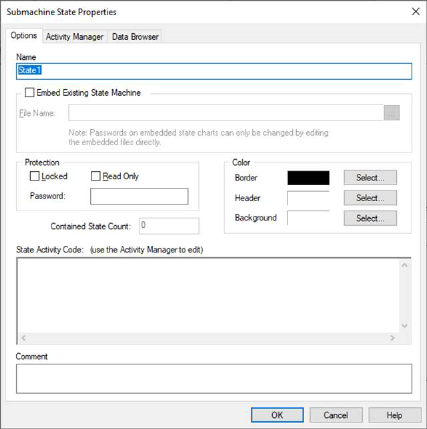 in the header distinguishes
it from a simple state.
in the header distinguishes
it from a simple state.A submachine encapsulates one or
more states. The  in the header distinguishes
it from a simple state.
in the header distinguishes
it from a simple state.
To move to the next lower level of a submachine, double-click its header.
A state chart that contains a submachine is called the containing state chart. You can have multiple levels of containing state charts. Transitions in the containing state chart can have entry and exit points of the inserted state chart as targets and sources.
When you exit a submachine, the connection point references appear on the edge of the submachine.

A submachine is semantically equivalent to a composite state with a single region. The entry, exit, and behavior actions and internal transitions are defined as part of the state. The state is entered when the condition starts and is exited as when the condition is complete.
You enter a submachine in the same way as you enter a non-orthogonal composite state. You can also enter and leave a submachine, in contrast to an ordinary composite state, via entry and exit points.
You can adjust its size of a submachine by dragging its corners.
Constraints
•Only submachines can have connection point references.
•The connection point references used as destinations and sources of transitions associated with a submachine must be defined as entry and exit points in the submachine state chart.

Background: Specifies the color of the decomposition region of the state.
Border: Specifies the color for the state borders.
Header: Specifies the color of the header region. To change the font color, use View > Fonts.
Comment: Indicates information or notes about the state. The comments only appear in the dialog.
Embed Existing State Machine: Reserved.
Name: Specifies a name for the state. The name can be alphanumeric characters. It must be unique with respect to other state names in the state chart.
Protection: Restricts access to the submachine. To lock the submachine state, activate Locked and enter a password in the Password box. To make the submachine read-only, activate Read-Only and enter a password in the Password box.
State Activity Code: Specifies one or more actions and associated behaviors. Enter and edit state activity code in Activity Manager.